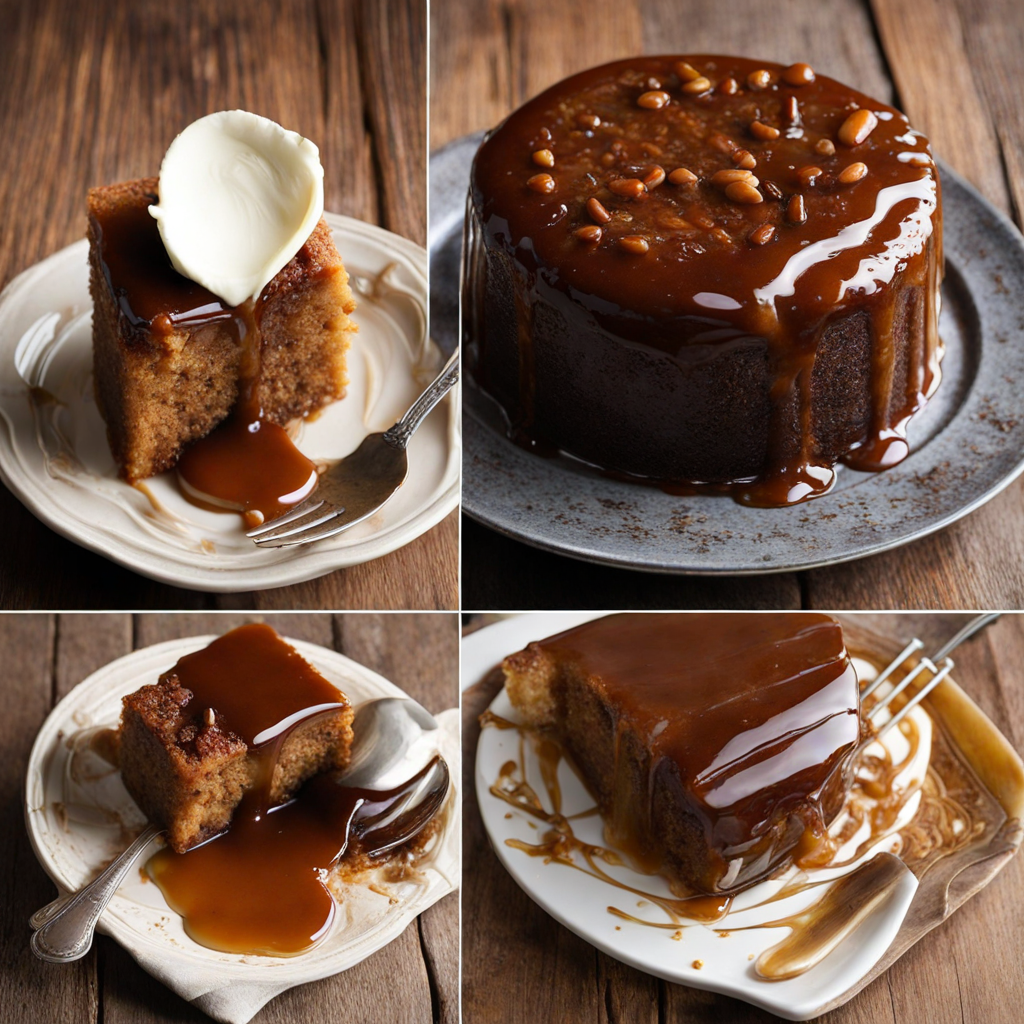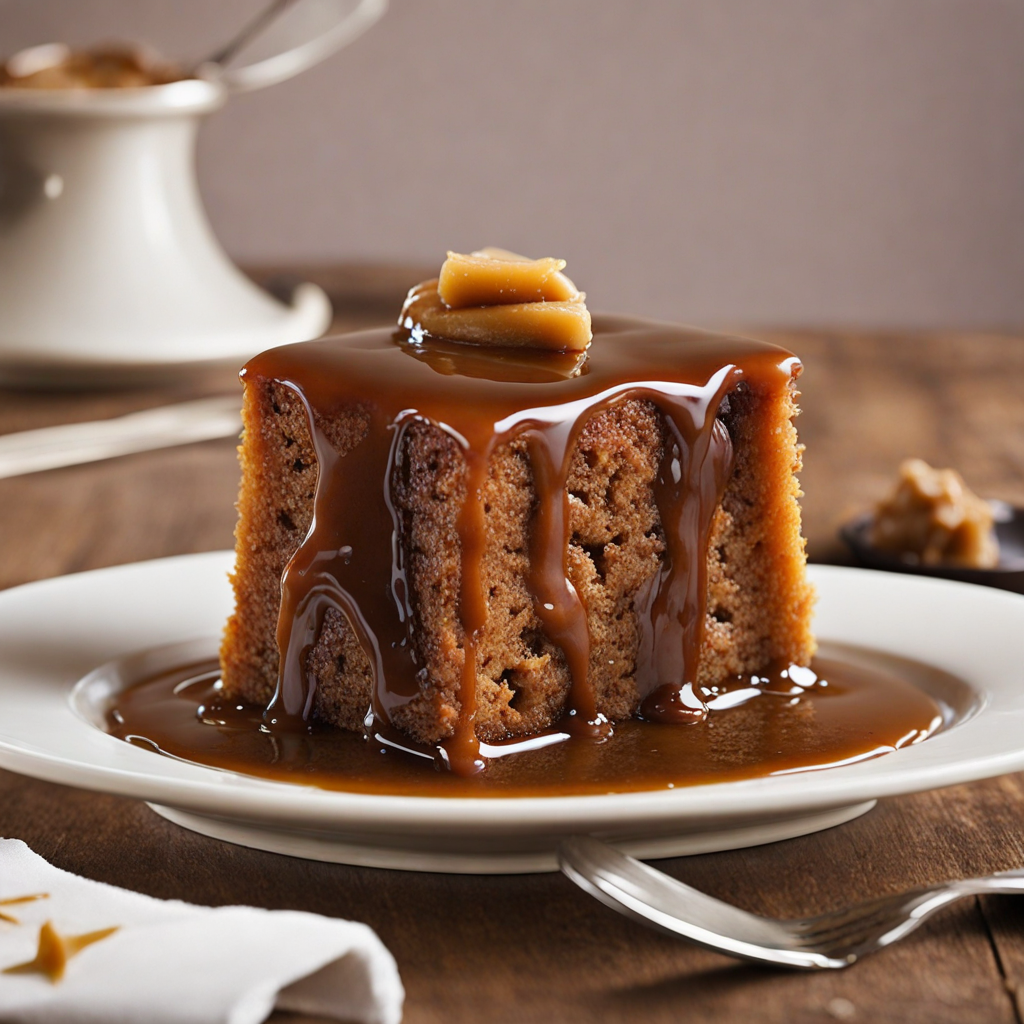Sticky Toffee Pudding
Sticky Toffee Pudding is a beloved dessert that hails from the United Kingdom, renowned for its rich and indulgent flavors. This moist sponge cake is made with finely chopped dates, which impart a natural sweetness and a unique, caramel-like flavor to the dish. The cake's texture is dense yet tender, creating a delightful contrast when paired with the sauce. The pudding is traditionally served warm, allowing the buttery, toffee sauce to seep into the sponge, enhancing its sweetness while providing a luscious, sticky finish that is both comforting and satisfying. The toffee sauce is an essential component of this dessert, crafted from a blend of brown sugar, butter, and cream, which is simmered together until it reaches a thick, glossy consistency. This sauce is generously poured over the warm pudding, resulting in a deliciously decadent treat that is often accompanied by a scoop of vanilla ice cream or a dollop of clotted cream. The interplay of the warm pudding and the cool cream adds another layer of enjoyment, making each bite a harmonious balance of flavors and temperatures. Sticky Toffee Pudding embodies the essence of British comfort food, often found on menus in pubs and restaurants across the UK. Its origins are somewhat debated, with some attributing its creation to the Lake District, while others claim it as a staple of English cuisine. Regardless of its beginnings, this dessert has captured the hearts of many, making it a must-try for anyone looking to explore the rich culinary landscape of the UK. With each mouthful, one can savor the deep, caramelized flavors and the delightful stickiness that makes Sticky Toffee Pudding an unforgettable experience.
How It Became This Dish
Sticky Toffee Pudding: A Sweet Journey Through Time Sticky Toffee Pudding (STP) is a quintessential British dessert, renowned for its rich, moist sponge cake drenched in a luscious toffee sauce. It is often served warm with a scoop of vanilla ice cream or a dollop of clotted cream. Its origins, cultural significance, and evolution over time reflect broader trends in British culinary history, making it a fascinating subject for exploration. Origins: The Birth of a Classic The precise origins of Sticky Toffee Pudding are shrouded in culinary mystery, with several competing claims to its invention. While the pudding as we know it began to gain prominence in the mid-20th century, its roots can be traced back to the traditional steamed puddings of the Victorian era. These steamed puddings, often made with dried fruits and served with rich sauces, set the stage for what would evolve into STP. Some food historians assert that STP originated in the Lake District of England, specifically at the Sharrow Bay Hotel in the 1960s. The story goes that Francis Coulson, the hotel’s owner, created it as a way to utilize leftover dates, a common pantry item at the time. He served it to guests, who were enamored by its rich flavor and delightful texture. This pudding quickly gained popularity, leading to its spread across the UK. Another claim comes from the Yorkshire region, where it is said that STP was a staple in the repertoire of home cooks. The pudding’s simple, hearty ingredients made it an ideal comfort food during the cold, damp winters of the North. Regardless of its true origin, it is clear that Sticky Toffee Pudding captured the hearts and palates of many, becoming a beloved dessert across Britain. Cultural Significance: A National Treasure Sticky Toffee Pudding is more than just a dessert; it embodies the warmth of British hospitality and the comfort of home-cooked meals. The pudding symbolizes the culinary ethos of the UK, where simple ingredients can be transformed into a dish of extraordinary indulgence. It represents a fusion of culinary traditions, drawing from the robustness of British steamed puddings, the influence of colonial ingredients like dates, and the evolving tastes of post-war Britain. In the post-war era, as rationing eased and food availability increased, people began to explore and experiment with desserts. STP emerged as a star of this new culinary landscape, offering a sweet escape from the stark realities of the previous decade. Its sticky sweetness and warm, gooey texture provided a sense of comfort and nostalgia, resonating with a population eager for indulgence. As the 20th century progressed, Sticky Toffee Pudding became a staple in restaurants and pubs. It was frequently featured on menus, representing the shift from traditional, heavy meals to lighter, more sophisticated dining. By the 1980s and 1990s, STP was firmly established as a classic British dessert, often evoking memories of family gatherings and festive occasions. Development Over Time: A Modern Classic The late 20th and early 21st centuries saw a revival of interest in traditional British cuisine, with chefs and home cooks alike embracing classic recipes. Sticky Toffee Pudding found itself at the forefront of this movement. The dish became a symbol of nostalgia, prompting many to seek out their grandmother's recipes or to experiment with new variations. Modern interpretations of STP have emerged, incorporating diverse ingredients and techniques. Chefs have played with flavor profiles, introducing elements like chocolate, caramelized bananas, and even seasonal fruits. While the classic version remains beloved, these innovations reflect contemporary culinary trends where traditional dishes are reimagined to suit modern palates. In recent years, Sticky Toffee Pudding has also gained international recognition, finding its way onto menus in restaurants across the globe. This global embrace of STP highlights the universal appeal of comfort food, transcending cultural boundaries. The pudding has become a symbol of British cuisine, celebrated not only in its homeland but also in culinary capitals worldwide. Sticky Toffee Pudding Today: A Cultural Icon Today, Sticky Toffee Pudding is more than just a dessert; it is an icon of British culture. It is often featured in cookbooks, food blogs, and television programs, showcasing its status as a beloved classic. The pudding is celebrated during special occasions, family gatherings, and holiday feasts, where it evokes a sense of nostalgia and togetherness. In the realm of food tourism, STP has become a must-try dish for visitors to the UK. Restaurants and pubs across the country proudly serve their versions of the pudding, often accompanied by unique twists. Some establishments offer STP with salted caramel sauce, while others may top it with a scoop of locally made ice cream, enhancing the experience while preserving the essence of the dish. The rise of social media has also played a role in the pudding’s popularity, with countless food enthusiasts sharing their STP creations online. This digital phenomenon has allowed for a vibrant community of home bakers and professional chefs to exchange recipes, tips, and personal stories, further solidifying the pudding's place in modern culinary culture. Conclusion: The Enduring Legacy of Sticky Toffee Pudding Sticky Toffee Pudding is a testament to the rich tapestry of British culinary history. Its origins, steeped in tradition, and its evolution, marked by innovation and creativity, reflect the dynamic nature of food culture in the UK. As a beloved dessert, it not only satisfies the sweet tooth but also serves as a reminder of the importance of comfort food in our lives. As we continue to explore the diverse world of food, Sticky Toffee Pudding stands as a symbol of warmth, nostalgia, and the joy of sharing a meal with loved ones. Whether enjoyed in a cozy pub, a family kitchen, or a fine dining establishment, STP will undoubtedly continue to delight generations to come, securing its place as a cherished British classic.
You may like
Discover local flavors from United Kingdom







